Abstract
The HAP1 protein (also known as APE/Ref-1) is a bifunctional human nuclear enzyme required for repair of apurinic/apyrimidinic sites in DNA and reactivation of oxidized proto-oncogene products. To gain insight into the biological roles of HAP1, the effect of expressing antisense HAP1 RNA in HeLa cells was determined. The constructs for antisense RNA expression consisted of either a full-length HAP1 cDNA or a genomic DNA fragment cloned downstream of the CMV promoter in pcDNAneo. Stable HeLa cell transfectants expressing HAP1 antisense RNA were found to express greatly reduced levels of the HAP1 protein compared to equivalent sense orientation and vector-only control transfectants. The antisense HAP1 transfectants exhibited a normal growth rate, cell morphology and plating efficiency, but were hypersensitive to killing by a wide range of DNA damaging agents, including methyl methanesulphonate, hydrogen peroxide, menadione, and paraquat. However, survival after UV irradiation was unchanged. The antisense transfectants were strikingly sensitive to changes in oxygen tension, exhibiting increased killing compared to controls following exposure to both hypoxia (1% oxygen) and hyperoxia (100% oxygen). Consistent with a requirement for HAP1 in protection against hypoxic stress, expression of the HAP1 protein was found to be induced in a time-dependent manner in human cells during growth under 1% oxygen. The possible involvement of a depletion of cellular glutathione being linked to the hypoxic stress-sensitive phenotype of the antisense HAP1 transfectants came from the finding that they also exhibited hypersensitivity to buthionine sulphoximine, an inhibitor of glutathione biosynthesis. We conclude that the HAP1 protein is a key factor in cellular protection against a wide variety of cellular stresses, including DNA damage and a change in oxygen tension.
Full text
PDF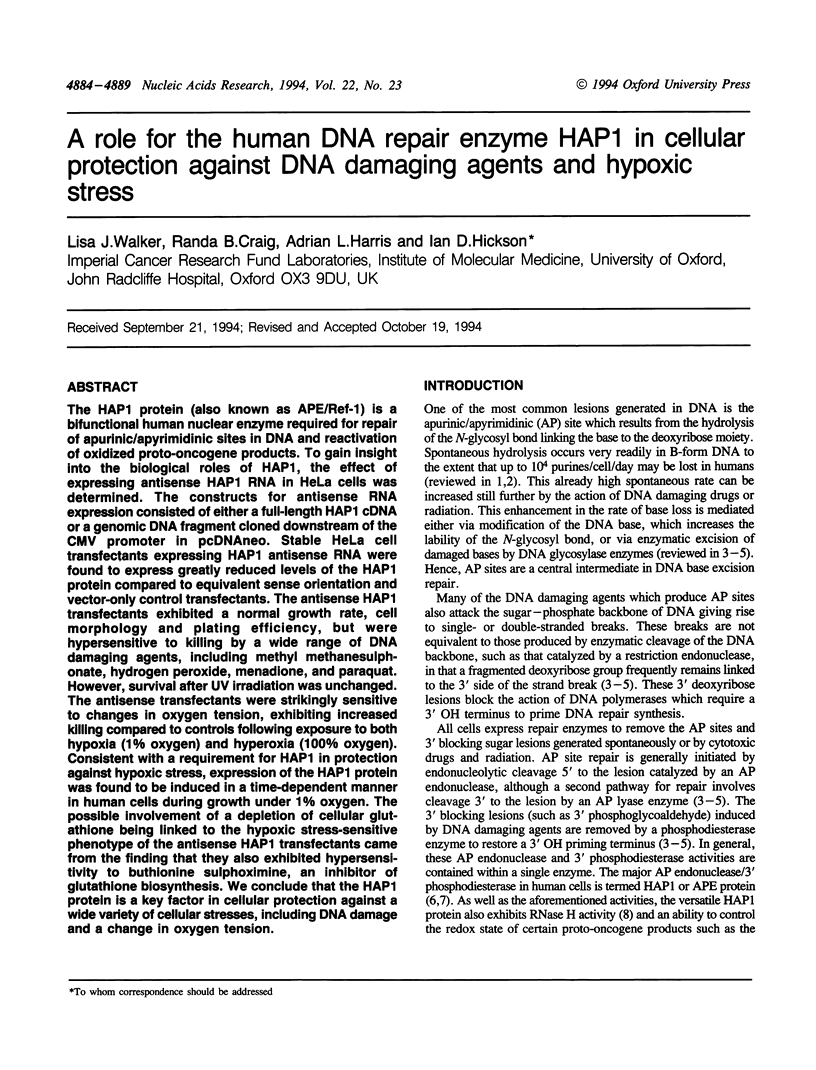
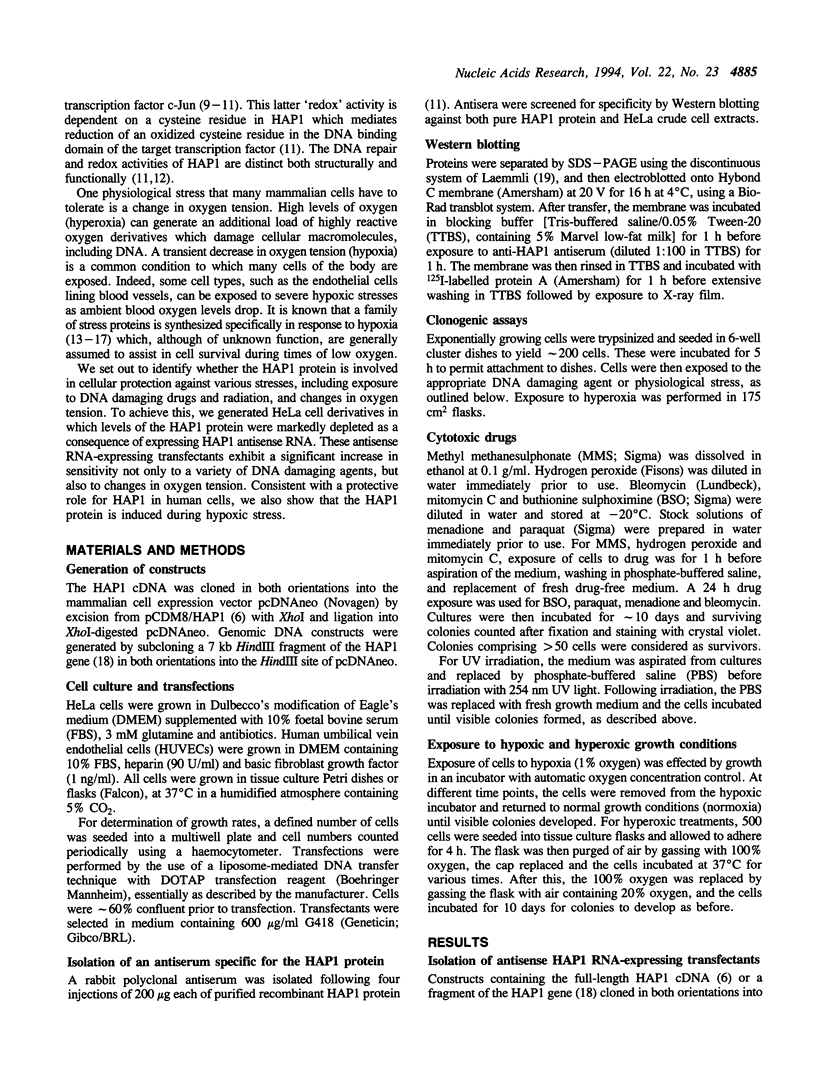

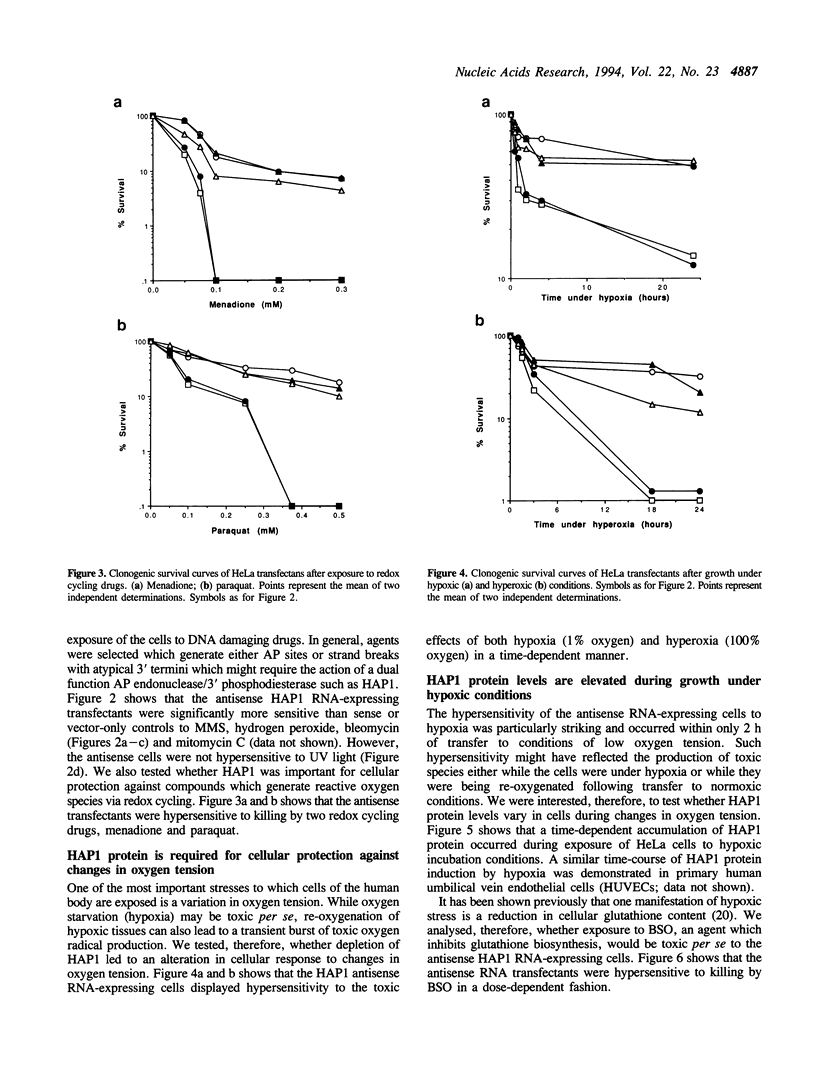
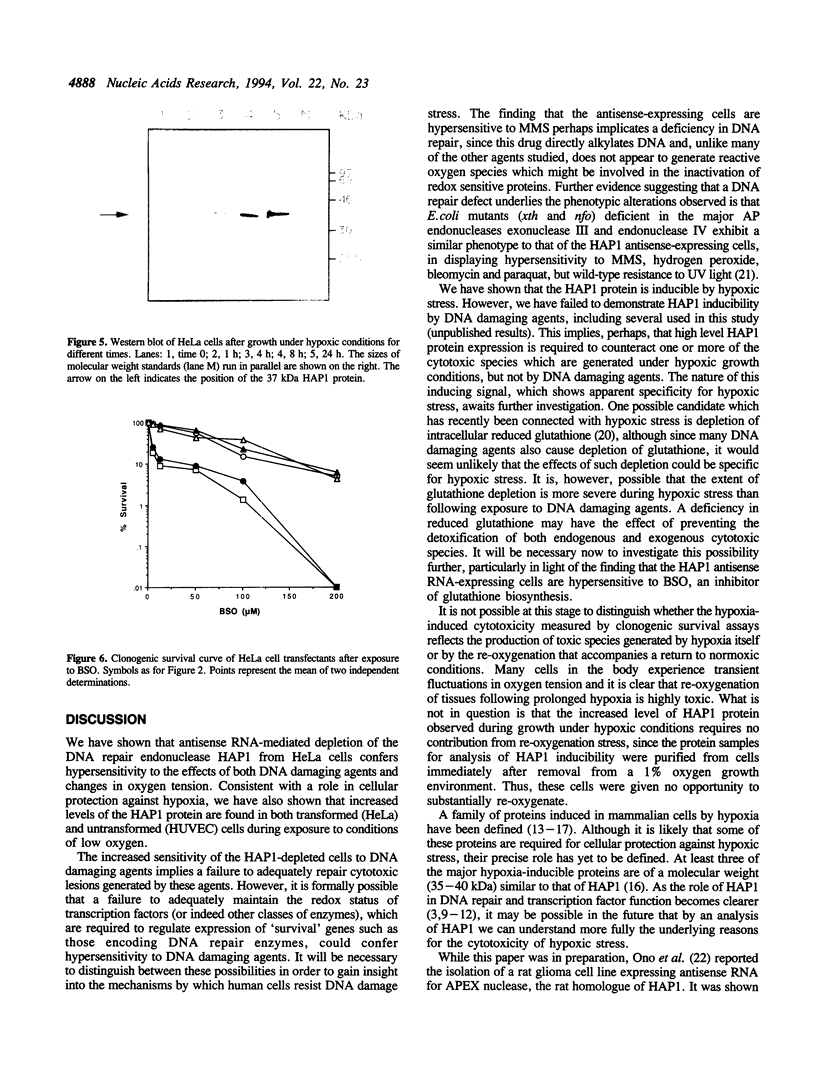
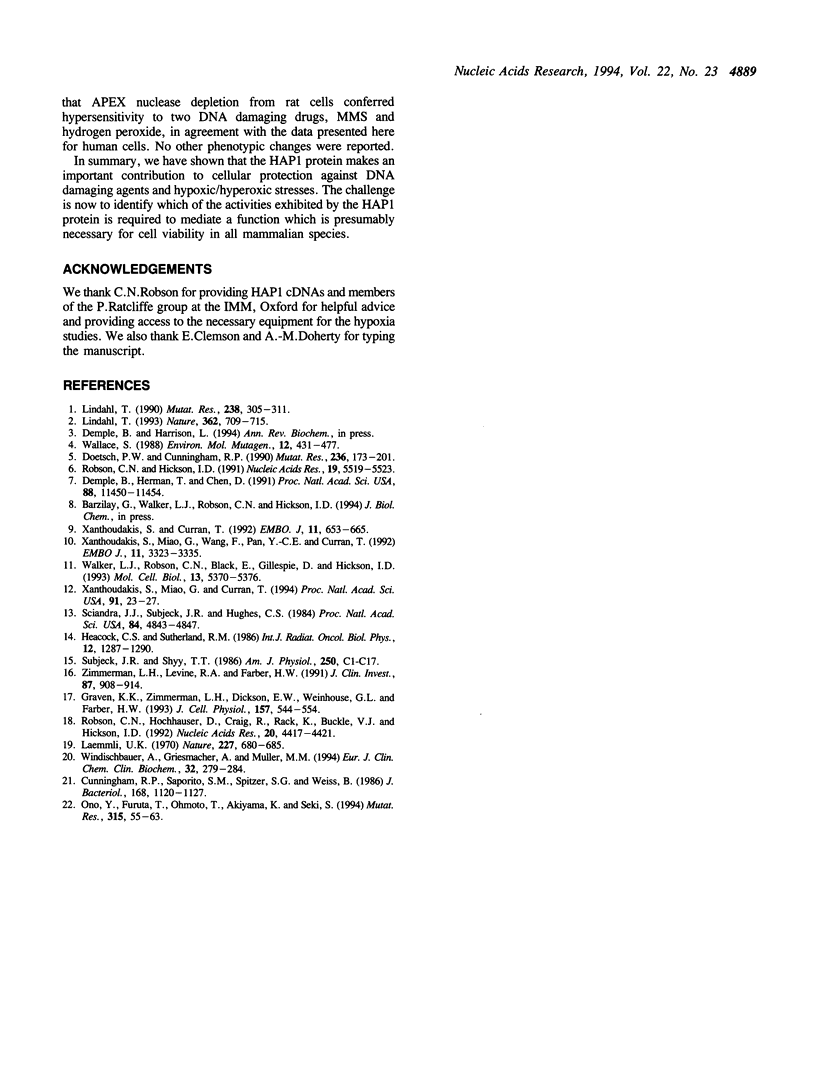
Images in this article
Selected References
These references are in PubMed. This may not be the complete list of references from this article.
- Cunningham R. P., Saporito S. M., Spitzer S. G., Weiss B. Endonuclease IV (nfo) mutant of Escherichia coli. J Bacteriol. 1986 Dec;168(3):1120–1127. doi: 10.1128/jb.168.3.1120-1127.1986. [DOI] [PMC free article] [PubMed] [Google Scholar]
- Demple B., Herman T., Chen D. S. Cloning and expression of APE, the cDNA encoding the major human apurinic endonuclease: definition of a family of DNA repair enzymes. Proc Natl Acad Sci U S A. 1991 Dec 15;88(24):11450–11454. doi: 10.1073/pnas.88.24.11450. [DOI] [PMC free article] [PubMed] [Google Scholar]
- Doetsch P. W., Cunningham R. P. The enzymology of apurinic/apyrimidinic endonucleases. Mutat Res. 1990 Sep-Nov;236(2-3):173–201. doi: 10.1016/0921-8777(90)90004-o. [DOI] [PubMed] [Google Scholar]
- Graven K. K., Zimmerman L. H., Dickson E. W., Weinhouse G. L., Farber H. W. Endothelial cell hypoxia associated proteins are cell and stress specific. J Cell Physiol. 1993 Dec;157(3):544–554. doi: 10.1002/jcp.1041570314. [DOI] [PubMed] [Google Scholar]
- Heacock C. S., Sutherland R. M. Induction characteristics of oxygen regulated proteins. Int J Radiat Oncol Biol Phys. 1986 Aug;12(8):1287–1290. doi: 10.1016/0360-3016(86)90155-0. [DOI] [PubMed] [Google Scholar]
- Laemmli U. K. Cleavage of structural proteins during the assembly of the head of bacteriophage T4. Nature. 1970 Aug 15;227(5259):680–685. doi: 10.1038/227680a0. [DOI] [PubMed] [Google Scholar]
- Lindahl T. Instability and decay of the primary structure of DNA. Nature. 1993 Apr 22;362(6422):709–715. doi: 10.1038/362709a0. [DOI] [PubMed] [Google Scholar]
- Lindahl T. Repair of intrinsic DNA lesions. Mutat Res. 1990 May;238(3):305–311. doi: 10.1016/0165-1110(90)90022-4. [DOI] [PubMed] [Google Scholar]
- Ono Y., Furuta T., Ohmoto T., Akiyama K., Seki S. Stable expression in rat glioma cells of sense and antisense nucleic acids to a human multifunctional DNA repair enzyme, APEX nuclease. Mutat Res. 1994 Jul;315(1):55–63. doi: 10.1016/0921-8777(94)90028-0. [DOI] [PubMed] [Google Scholar]
- Robson C. N., Hickson I. D. Isolation of cDNA clones encoding a human apurinic/apyrimidinic endonuclease that corrects DNA repair and mutagenesis defects in E. coli xth (exonuclease III) mutants. Nucleic Acids Res. 1991 Oct 25;19(20):5519–5523. doi: 10.1093/nar/19.20.5519. [DOI] [PMC free article] [PubMed] [Google Scholar]
- Robson C. N., Hochhauser D., Craig R., Rack K., Buckle V. J., Hickson I. D. Structure of the human DNA repair gene HAP1 and its localisation to chromosome 14q 11.2-12. Nucleic Acids Res. 1992 Sep 11;20(17):4417–4421. doi: 10.1093/nar/20.17.4417. [DOI] [PMC free article] [PubMed] [Google Scholar]
- Sciandra J. J., Subjeck J. R., Hughes C. S. Induction of glucose-regulated proteins during anaerobic exposure and of heat-shock proteins after reoxygenation. Proc Natl Acad Sci U S A. 1984 Aug;81(15):4843–4847. doi: 10.1073/pnas.81.15.4843. [DOI] [PMC free article] [PubMed] [Google Scholar]
- Subjeck J. R., Shyy T. T. Stress protein systems of mammalian cells. Am J Physiol. 1986 Jan;250(1 Pt 1):C1–17. doi: 10.1152/ajpcell.1986.250.1.C1. [DOI] [PubMed] [Google Scholar]
- Walker L. J., Robson C. N., Black E., Gillespie D., Hickson I. D. Identification of residues in the human DNA repair enzyme HAP1 (Ref-1) that are essential for redox regulation of Jun DNA binding. Mol Cell Biol. 1993 Sep;13(9):5370–5376. doi: 10.1128/mcb.13.9.5370. [DOI] [PMC free article] [PubMed] [Google Scholar]
- Wallace S. S. AP endonucleases and DNA glycosylases that recognize oxidative DNA damage. Environ Mol Mutagen. 1988;12(4):431–477. doi: 10.1002/em.2860120411. [DOI] [PubMed] [Google Scholar]
- Windischbauer A., Griesmacher A., Müller M. M. In vitro effects of hypoxia and reoxygenation on human umbilical endothelial cells. Eur J Clin Chem Clin Biochem. 1994 Apr;32(4):279–284. doi: 10.1515/cclm.1994.32.4.279. [DOI] [PubMed] [Google Scholar]
- Xanthoudakis S., Curran T. Identification and characterization of Ref-1, a nuclear protein that facilitates AP-1 DNA-binding activity. EMBO J. 1992 Feb;11(2):653–665. doi: 10.1002/j.1460-2075.1992.tb05097.x. [DOI] [PMC free article] [PubMed] [Google Scholar]
- Xanthoudakis S., Miao G. G., Curran T. The redox and DNA-repair activities of Ref-1 are encoded by nonoverlapping domains. Proc Natl Acad Sci U S A. 1994 Jan 4;91(1):23–27. doi: 10.1073/pnas.91.1.23. [DOI] [PMC free article] [PubMed] [Google Scholar]
- Xanthoudakis S., Miao G., Wang F., Pan Y. C., Curran T. Redox activation of Fos-Jun DNA binding activity is mediated by a DNA repair enzyme. EMBO J. 1992 Sep;11(9):3323–3335. doi: 10.1002/j.1460-2075.1992.tb05411.x. [DOI] [PMC free article] [PubMed] [Google Scholar]
- Zimmerman L. H., Levine R. A., Farber H. W. Hypoxia induces a specific set of stress proteins in cultured endothelial cells. J Clin Invest. 1991 Mar;87(3):908–914. doi: 10.1172/JCI115097. [DOI] [PMC free article] [PubMed] [Google Scholar]




